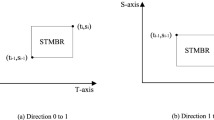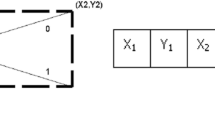Abstract
Indexing moving objects (MO) is a hot topic in the field of moving objects databases since many years. An impressive number of access methods have been proposed to optimize the processing of MO-related queries. Several methods have focused on spatio-temporal range queries, which represent the foundation of MO trajectory queries. Surprisingly, only a few of them consider that the objects movements are constrained. This is an important aspect for several reasons ranging from better capturing the relationship between the trajectory and the network space to more accurate trajectory representation with lower storage requirements. In this paper, we propose T-PARINET, an access method to efficiently retrieve the trajectories of objects moving in networks. T-PARINET is designed for continuous indexing of trajectory data flows. The cornerstone of T-PARINET is PARINET, an efficient index for historical trajectory data. The structure of PARINET is based on a combination of graph partitioning and a set of composite B+-tree local indexes. Because the network can be modeled using graphs, the partitioning of the trajectory data makes use of graph partitioning theory and can be tuned for a given query load and a given data distribution in the network space. The tuning process is built on a good quality cost model that is supplied with PARINET. The advantage of having a cost model is twofold; it allows a better integration of the index into the query optimizer of any DBMS, and it permits tuning the index structure for better performance. The tuning process can be performed before the index creation in the case of historical data or online in the case of indexing data flows. In fact, massive online updates can degrade the index quality, which can be measured by the cost model. We propose a specific maintenance process that results into T-PARINET. We study different types of queries and provide an optimized configuration for several scenarios. T-PARINET can easily be integrated into any RDBMS, which is an essential asset particularly for industrial or commercial applications. The experimental evaluation under an off-the-shelf DBMS shows that our method is robust. It also significantly outperforms the reference R-tree-based access methods for in-network trajectory databases.
Similar content being viewed by others
References
Botea V., Mallett D., Nascimento M.A., Sander J.: PIST: an efficient and practical indexing technique for historical spatio-temporal point data. GeoInformatica 12(2), 143–168 (2008)
Brinkhoff T.: A framework for generating network-based moving objects. GeoInformatica 6(2), 153–180 (2002)
Chen, S., Ooi, B.C., Tan, K.L., Nascimento, M.A.: The ST2B-tree: a self-tunable spatio-temporal B+-tree index for moving objects. In: Proceedings of the ACM SIGMOD, pp. 29–42 (2008)
de Almeida V.T., Guting R.: Indexing the trajectories of moving objects in networks. GeoInformatica 9(1), 30–60 (2005)
Frentzos, E.: Indexing objects moving on fixed networks. In: Proceedings SSTD, pp. 289–305 (2003)
Garey M.R., Johnson D.S.: Computers and Intractability. A Guide to the Theory of NP-Completeness, New York (1990)
Güting R.H., de Almeida V.T., Ding Z.: Modeling and querying moving objects in networks. VLDB J. 15(2), 165–190 (2006)
Hadjieleftheriou M., Kollios G., Tsotras J., Gunopulos D.: Indexing spatiotemporal archives. VLDB J. 15(2), 143–164 (2006)
Jensen, C.S., Lin, D., Ooi, B.C.: Query and update efficient B+-tree based indexing of moving objects. In: Proceedings of the VLDB, pp. 768–779 (2004)
Karypis G., Kumar V.: A fast and highly quality multilevel scheme for partitioning irregular graphs. SIAM J. Sci. Comput. 20(1), 359–392 (1999)
Kriegel, H.-P., Pötke, M., Seidl, T.: Managing intervals efficiently in object-relational databases. In: Proceedings of the VLDB (2000)
Lin, D., Jensen, C.S., Ooi, B.C., Saltenis, S.: Efficient indexing of the historical, present, and future positions of moving objects. In: Proceedings of the MDM, pp. 59–66 (2005)
METIS—Family of multilevel partitioning algorithms. [On-line]. Available: http://glaros.dtc.umn.edu/gkhome/views/metis
Mokbel, M.F., Xiong, X., Aref, W.G.: SINA: scalable incremental processing of continuous queries in spatio-temporal databases. In: Proceedings of the SIGMOD, pp. 623–634 (2004)
Patel, J.M., Arbor, A., Chen, Y., Chakka, V.P.: STRIPES: an efficient index for predicted trajectories. In: Proceedings of the ACM SIGMOD, pp. 635–646 (2004)
Pelanis M., Saltenis S., Jensen C.S.: Indexing the past, present, and anticipated future positions of moving objects. ACM Trans. Database Syst. 31(1), 255–298 (2006)
Pfoser, D., Jensen, C.S.: Indexing of network-constrained moving objects. In: Proceedings of the ACM-GIS, pp. 25–32 (2003)
Prabhakar S., Xia Y., Kalashnikov D.V., Aref W.G., Hambrusch S.E.: Query indexing and velocity constrained indexing: scalable techniques for continuous queries on moving objects. IEEE Trans. Comput 51(10), 1124–1140 (2002)
Saltenis, S., Jensen, C.S., Leutenegger, S.T., Lopez, M.A.: Indexing the positions of continuously moving objects. In: Proceedings of the ACM SIGMOD, pp. 331–342 (2000)
Sandu Popa, I., Zeitouni, K, Oria, V., Barth, D., Vial, S.: PARINET: a tunable access method for in-network trajectories. In: Proceedings of the ICDE, pp. 177–188 (2010)
Sandu Popa, I., Zeitouni, K, Oria, V., Barth, D., Vial, S.: Indexing in-network trajectory flows. Technical Report #539, 2011/31, PRiSM Laboratory (2011)
Speicys L., Jensen C.S.: Enabling location-based services—multi-graph representation of transportation networks. GeoInformatica 12(2), 219–253 (2008)
Sun, J., Papadias, D., Liu, B.: Querying about the past, the present and the future in spatio-temporal databases. In: Proceedings of the ICDE, pp. 202–213 (2004)
Tao, Y., Papadias, D.: MV3R-Tree: a spatio-temporal access method for timestamp and interval queries. In: Proceedings of the VLDB, pp. 431–440 (2001)
Tao, Y., Papadias, D., Shen, Q.: Continuous nearest neighbor search. In: Proceedings of the VLDB (2002)
Tao, Y., Papadias, D., Sun, J.: The TPR*-tree: an optimized spatio-temporal access method for predictive queries. In: Proceedings of the VLDB, pp. 790–801 (2003)
Theodoridis Y., Stefanakis E., Sellis T.K.: Efficient cost models for spatial queries using R-trees. IEEE Trans. Knowl. Data Eng. 12(1), 19–32 (2000)
Author information
Authors and Affiliations
Corresponding author
Rights and permissions
About this article
Cite this article
Sandu Popa, I., Zeitouni, K., Oria, V. et al. Indexing in-network trajectory flows. The VLDB Journal 20, 643–669 (2011). https://doi.org/10.1007/s00778-011-0236-8
Received:
Revised:
Accepted:
Published:
Issue Date:
DOI: https://doi.org/10.1007/s00778-011-0236-8




